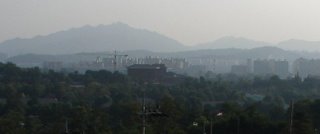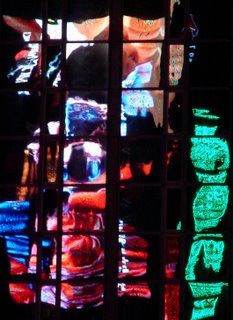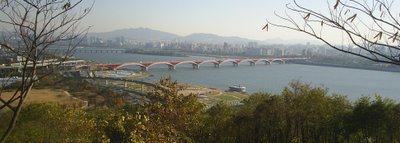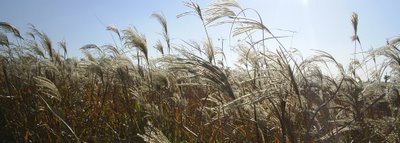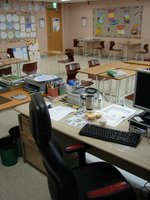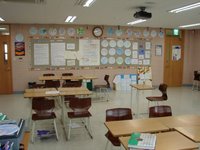 It's been ages I know, but the end of the semester is coming and things are hectic (you'll hear me making this type of excuse often:-))
It's been ages I know, but the end of the semester is coming and things are hectic (you'll hear me making this type of excuse often:-)) Friday, December 01, 2006
Konglish Part 1
 It's been ages I know, but the end of the semester is coming and things are hectic (you'll hear me making this type of excuse often:-))
It's been ages I know, but the end of the semester is coming and things are hectic (you'll hear me making this type of excuse often:-)) Wednesday, November 22, 2006
Funny Fashion Photos
Check out Canada.com's hilarious photo-by-photo commentary on some of the wacky outfits on display at the recent "Ubiquitous Fashionable Computer Fashion Show" in Koyang City, near Seoul. http://www.canada.com/topics/technology/photogalleries/wearable.html?g=0
Monday, November 20, 2006
Korean Culture Through TV. Part One: Women
But Korean TV is undoubtedly different, as you would expect. Whether a country's TV offerings reflect or create the everyday reality of ordinary people is always a subject of debate among those who care about such things.
I only wanted to show you some of the things I noticed about Korean TV that people elsewhere might find interesting.
So I recorded bits from TV dramas, movies, and advertising that I felt were representative of what is on screen every day here.
VIDEO 1
VIDEO 2
VIDEO 3
Today, I wanted to show how women are portrayed on the tube here. Feel free to comment. Are these depictions of women different from those you would see where you are from? Are these images positive in your eyes? Are they an accurate reflection of the roles played by Korean women and their character as a group and as individuals? Or are these stereotypes? What message do these images convey?
Sunday, November 19, 2006
Jeju Tangerines

Yes, there are three main pillars of the economy on Jeju: tangerines (and an ever-diversifying range of citrus), fishing and tourism. Yesterday, a great friend of many years (Robert) offered to lend me his Honda Shadow motorbike for a tour in the warm mid-November sunshine - an offer I gratefully accepted. It was a truly glorious day for a ride and I was having a lovely time of it until mechanical issues ensued:-) So- I was forced to stop alongside the road at a tangerine orchard where an "ah-joom-mah" (auntie) phoned a bike shop for me. As we waited, we shared some Vitamin C and chatted about the evils of the now-in-negociation Korea-US Free Trade Agreement. I tried to argue the point (one I sincerely believe in, by the way) that Jeju citrus could go head-to-head with anything the states produces and win hands-down. She was not convinced. I expect to see her on TV throwing Molatov cocktails at the next anti-FTA demonstration. Power to the people, ajuma, power to the people.
Thursday, November 09, 2006
Palace Guards
 From 1392 to 1910, Korea was known as the "Kingdom of Great Joseon" and was ruled by a royal family which was deposed and sent to Japan for re-education after the Japanese occupation began. The capital of Joseon, relocated to Hanyang (later Seoul), was the site of the Royal Palace at Gyung-Bohk-Goong (경복궁). The palace, parts of which were destroyed by the Japanese occupiers, has been and continues to be restored as a tourist attraction. On national holidays and on weekends during the summer, the palace, now a tourist attraction, is the site of re-enactments of royal parades and changing-of-the-guard ceremonies, one of which is pictured here.
From 1392 to 1910, Korea was known as the "Kingdom of Great Joseon" and was ruled by a royal family which was deposed and sent to Japan for re-education after the Japanese occupation began. The capital of Joseon, relocated to Hanyang (later Seoul), was the site of the Royal Palace at Gyung-Bohk-Goong (경복궁). The palace, parts of which were destroyed by the Japanese occupiers, has been and continues to be restored as a tourist attraction. On national holidays and on weekends during the summer, the palace, now a tourist attraction, is the site of re-enactments of royal parades and changing-of-the-guard ceremonies, one of which is pictured here. 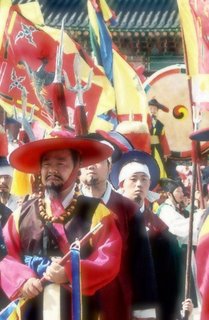 I took these photos on a film camera and when I had digital images made from the negatives, the photos turned out rather grainy. I decided to soften the images to solve the problem - it lends a faded, glimse-into-the-past kind of effect that I think is actually quite nice.
I took these photos on a film camera and when I had digital images made from the negatives, the photos turned out rather grainy. I decided to soften the images to solve the problem - it lends a faded, glimse-into-the-past kind of effect that I think is actually quite nice.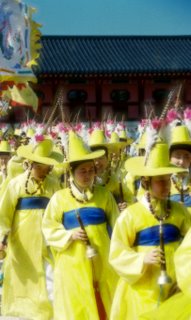 Why can't military, police, and public officials have uniforms like this anymore? I, for one, would love to wear hanbok to work every day.
Why can't military, police, and public officials have uniforms like this anymore? I, for one, would love to wear hanbok to work every day.

Monday, November 06, 2006
Swirling Lights

Sunday, November 05, 2006
Friday, November 03, 2006
Takraw Balls

Thursday, November 02, 2006
Blue Mood
 Back to Chunn-Gyey-Chunn (천계천), the rehabilitated stream system in the center of Seoul...
Back to Chunn-Gyey-Chunn (천계천), the rehabilitated stream system in the center of Seoul...And a little more abstract - a close-up. Looks a little like steel cables or TV noise...

Wednesday, November 01, 2006
아줌마 tending to her 과일
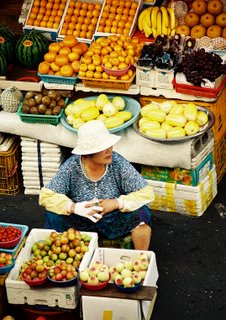 Single white glove and hat - she obviously still thinks "Thriller" was the best album of all time."Ow!!"
Single white glove and hat - she obviously still thinks "Thriller" was the best album of all time."Ow!!" 아줌마 or "AH-joom-mah" usually translates into "auntie" in English and is usually used to describe or address any woman who is married and / or over the age of about 30. Younger Korean women dread the day they will be called 아줌마 , perhaps partly because of the stigma that comes with it. These ladies hold a lot of power in their families (ALL the power). Many have had to endure many hard times in their lives and are determined that their children will have better lives - and God help anyone who gets in the way. Any semblance of feminine submissiveness in youth gives way to blunt, brute force and plain-talking, line-jumping aggressiveness that can be intimidating. As a teacher who deals with Korean parents all the time, I never quite get used to it. However, if you don't get on their bad side, these aunties can be among the most dedicated, caring, selfless, and funny ladies you will ever meet. As an example, one ah-joom-mah in a restaurant I frequented used to yell at me for not finishing my rice (bloody near a capital offense in Korea). The next time I visited, if I was a good boy and cleaned my plate, she would teach me words of Jeju dialect and then laugh her 엉덩이 off with her friends as she had me repeat to all of them what I had learned . I'm always happy to be of entertainment to others, even at my own expense - "Sit, Ubu, sit. Good dog! Now roll over!"
Tuesday, October 31, 2006
Namdaemoon: "Great South Gate"
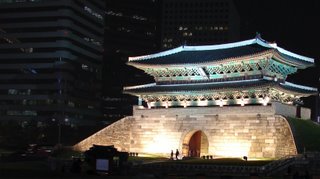 The wildest thing about the area now is the traffic, situated as it is, at the intersection of 5 major city streets and several lanes and alleys. It is only a five minute walk from Seoul Station, City Hall, and the ancient Doksu Palace.It gave its name to the adjacent Namdaemoon Market, one of the largest traditional markets in Korea, a hagglers paradise of sorts (and the best place in the city to get camera lenses and eyeglasses). This gate and the rotary that carries traffic around it is at the heart of Seoul's old downtown and the "Gahng Buk" or "North of the River" area of Seoul.
The wildest thing about the area now is the traffic, situated as it is, at the intersection of 5 major city streets and several lanes and alleys. It is only a five minute walk from Seoul Station, City Hall, and the ancient Doksu Palace.It gave its name to the adjacent Namdaemoon Market, one of the largest traditional markets in Korea, a hagglers paradise of sorts (and the best place in the city to get camera lenses and eyeglasses). This gate and the rotary that carries traffic around it is at the heart of Seoul's old downtown and the "Gahng Buk" or "North of the River" area of Seoul.Monday, October 30, 2006
City of Light
Sunday, October 29, 2006
What Is It?
Anyone able to guess what this is and where in Seoul it can be found?
Saturday, October 28, 2006
A Little Melo With Your Drama?
 www.youtube.com/watch?v=vRvzv3Sc8do
www.youtube.com/watch?v=vRvzv3Sc8doMystery Veg

Friday, October 27, 2006
Laos Journey (continued): Hot and Sour

Thursday, October 26, 2006
Tied to the Land

Monday, October 23, 2006
Fall in Seoul
Saturday, October 21, 2006
Beachside


Thursday, October 19, 2006
Yangjay Stream

Wednesday, October 18, 2006
Tuesday, October 17, 2006
KIS - Where I Work
Well, as I thought, once I got back to work, it became increasingly difficult to find time to update my blog but I have a few minutes tonight so I thought I would post a few pics of where I work, the Korea International School in Bundang. This August, we moved into our new facility and it is a real pleasure to work in a building like this with such talented teachers and students.


Thursday, October 12, 2006
Wednesday, October 11, 2006
Saturday, October 07, 2006
Two of the World's Three Best Nephews-And Nieces Too!
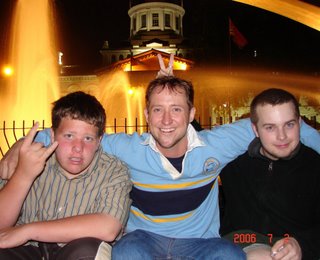 The above is Canada Day, 2006 in Kingston with Devin, the budding flyboy, and Conor, the gamer-genius, my sister's boys.
The above is Canada Day, 2006 in Kingston with Devin, the budding flyboy, and Conor, the gamer-genius, my sister's boys. 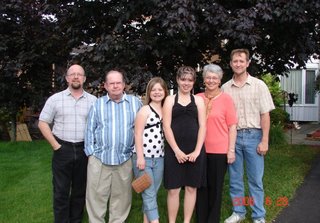 Above, from left, Phil, oldest brother and god (small "g") in his own right, Dad, Jessica, Stephanie (whose 8th Grade Grad it was that day), Mom, and a horribly coiffed moi at the homestead in Orangeville.
Above, from left, Phil, oldest brother and god (small "g") in his own right, Dad, Jessica, Stephanie (whose 8th Grade Grad it was that day), Mom, and a horribly coiffed moi at the homestead in Orangeville.
To MJ, Louise, Dale, Bill, and all other beloved, you shall have your day.
Chu'seok: Heaven and Hell
 How very lovely, you say? Well, except that the holiday involves, for most, a lot more stress than joyous familial frolic. First off, being with the family involves making train or flight reservations months in advance or having to face up to 20 hours on the roads in an endless traffic jam. This holiday season, some 39 million people were on the move in-country, with another 300,000 estimated to be traveling overseas. Then, once you have arrived, the lady of the family is expected to log countless hours preparing festive traditional rice cakes (song-pyun) and any number of other delicacies for the men, who generally sit with the elder men and get profusely plastered, in keeping with tradition. For those unfortunate enough to be unmarried by 25, there are the inevitable questions about marriage and the ticking of the biological clock.
How very lovely, you say? Well, except that the holiday involves, for most, a lot more stress than joyous familial frolic. First off, being with the family involves making train or flight reservations months in advance or having to face up to 20 hours on the roads in an endless traffic jam. This holiday season, some 39 million people were on the move in-country, with another 300,000 estimated to be traveling overseas. Then, once you have arrived, the lady of the family is expected to log countless hours preparing festive traditional rice cakes (song-pyun) and any number of other delicacies for the men, who generally sit with the elder men and get profusely plastered, in keeping with tradition. For those unfortunate enough to be unmarried by 25, there are the inevitable questions about marriage and the ticking of the biological clock.
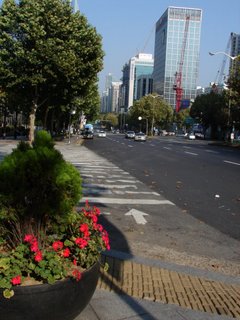
Seoul: Then and Now (Part 1)
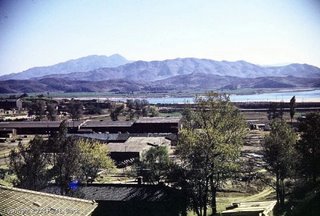 The second photo was taken today, and shows a similar view, albeit from a bit further away and to the West (they wouldn't let me on the Yongsan base to take photos - GO FIGURE!) but shows essentially the same thing. Those lush green fields to the south are long gone. The area south of the river, all farmland in 1960, is now home to some 7 million people and the dense development stretches well beyond the furthest of those mountains in the background.
The second photo was taken today, and shows a similar view, albeit from a bit further away and to the West (they wouldn't let me on the Yongsan base to take photos - GO FIGURE!) but shows essentially the same thing. Those lush green fields to the south are long gone. The area south of the river, all farmland in 1960, is now home to some 7 million people and the dense development stretches well beyond the furthest of those mountains in the background.